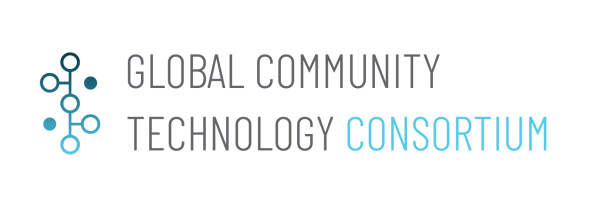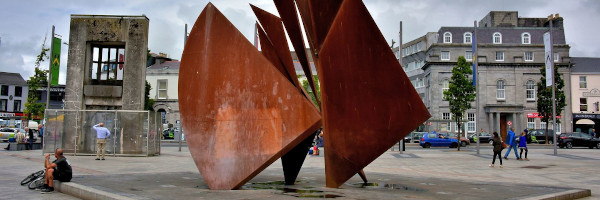Galway Smart City
| Galway Smart City | |
|---|---|

| |
 Eyre Square Galway | |
| Team Organizations | Dew Software Inc National University of Ireland Galway City Council |
| Team Leaders | Shivakumar Mathapathi CEO Dew Mobility |
| Participating Municipalities | Galway City |
| Status | Launched |
| Document | [[File:Tech Jam Presentation|Download]] |
Description
Galway has pioneered some smart city ideas. It has implemented an award winning 3 bin recycling scheme that achieved higher levels of recycling than any before seen in Ireland. Galway was the first city in Ireland to achieve the European Energy Award. It is involved in a number of projects to reduce energy usage and to lower the levels of carbon emissions. It adopted a smarter travel policy, including a new public transport strategy, various schemes to encourage citizen’s mobility (cycling and walking) and improved traffic management systems. The ‘slow the flow’ programme reduced the amount of drinking water being wasted in the City. In terms of education, Galway was possibly the first City in the world to achieve Green Flag status in all of its schools.
Galway Smart City - Light Pollution This project ensure the design of external lighting that minimizes the incidence of light pollution, glare and spillage into the surrounding environment and has due regard to the visual and residential amenities of surrounding areas.
Galway Smart City - Air Quality and Noise This project aims for maintaining air quality to a satisfactory standard by regulating and monitoring atmospheric emissions in accordance with EU directives on air quality, by promoting and supporting initiatives to reduce air pollution, by increasing the use of public transport, developing urban woodland, encouraging tree planting and conserving green open space.
Challenges
Strategic goals of the Galway City Development Plan
- Promote balanced and sustainable economic development that will enable Galway City to fulfill its role as a National Gateway and a Regional Centre, providing sufficient employment opportunities and appropriate services.
- Use the role of the Gateway to harness the strengths and maximize the economic development of the region.
- Provide for a built and natural environment that is of high quality and that contributes to providing a good quality of life for residents and visitors and affords sustainable transportation opportunities.
- Promote social inclusion in accordance with the National Anti-Poverty Strategy 2007 and the National Action Plan for Social Inclusion 2007-2016 and aim to reduce and ultimately eliminate poverty levels in accordance with national targets.
- Promote the reduction of greenhouse gas emissions through proactive measures in line with EU commitments to tackle climate change.
Air Quality and Noise
- Maintain air quality to a satisfactory standard by regulating and monitoring atmospheric emissions in accordance with EU directives on air quality, by promoting and supporting initiatives to reduce air pollution, by increasing the use of public transport, developing urban woodland, encouraging tree planting and conserving green open space.
- Ensure the design of development incorporates measures to minimize noise levels in their design and reduce the emission and intrusion of any noise or vibration that might give reasonable cause for annoyance, where appropriate.
- Consider the land use planning mitigation and protection measures and the strategic noise mapping of the city in the Galway ‘’’City Noise Action Plan’’’ 2008-2013 in the assessment of relevant development applications, where appropriate.
- Implement noise reduction measures as outlined in Galway City Noise Action Plan 2008-2013, with priority to those areas designated as worst affected, namely along the N6 (including Ros Caoin).
Light Pollution
- Ensure the design of external lighting minimizes the incidence of light pollution, glare and spillage into the surrounding environment and has due regard to the visual and residential amenities of surrounding areas.
Solutions
NA
Major Requirements
- Undertake strategic noise mapping; to determine exposure to environmental noise;
- Ensure information on environmental noise and its effects is made available to the public;
- Adopt action plans, based on the noise mapping results.
- Identification of areas required to be mapped
Strategic noise maps preparation for areas and infrastructure falling within defined criteria e.g. large agglomerations, major roads, railways and airports.
- Exposure to environmental noise
Determine exposure to environmental noise, with an aim to prevent and reduce environmental noise where necessary. The noise maps use harmonized (Equivalent level). The noise maps are to be used to assess the number of people annoyed and sleep-disturbed respectively throughout each member state in the European Union.
Performance Targets
| Key Performance Indicators (KPIs) | Measurement Methods |
|---|---|
|
Galway Smart City - Light Pollution
Galway Smart City - Air Quality and Noise
|
Standards, Replicability, Scalability, and Sustainability
- A key concept in the design process and deployment activity of the Light Pollution, Air Quality and Noise Monitoring Smart System is to utilize available open- standards, including: Using available high-performance, low-power, low-cost general-purpose development Internet of Things technologies, services and applications that can be interfaced with existing off-shelf industry standard sensors and communication devices (e.g., Bluetooth, Wi-Fi for GSM modules).
- A main characteristic on this project is the interconnectivity of application data and the use of industry standard communication technologies such as Wi-Fi 3G/4G Cellular and Satellite technologies for data transmissions and collection.
- By Incorporating open-cloud, (open source and Virtual infrastructures, i.e. OpenIoT an open source European IoT platform), the secure development of the platform is interactive with web and mobile applications and high-performance data analytics.
Complying with REST-API, MQTT and CoAP IoT Protocols for effective communication from sensor data to the EC OpenIoT server, the interoperability allows user to access the real time data on any desktop or mobile devices.
Replicability, Scalability, and Sustainability: Using open-source hardware and software platforms like OpenIoT and VITAL-IoT, and off-shelf internet of Things industry sensors, as well as incorporating standard communication protocols we ensures that the designed system is fully replicable.
A key design issue is to ensure that the network performance is scalable both vertically and horizontally. The vertical scalability (expanding the network reach) will be ensured through using standard communication links. Furthermore, through utilizing Amazon AWS and/or CISCO SPARK, we ensure availability of a high- performance data center where large number of users can access large set of monitoring nodes. The horizontal scalability (expanding node features) will be ensured through using open-source, low-cost hardware and on-board standard communication protocols.
Cybersecurity and Privacy
The system Ver 2.0 shall be designed to address cybersecurity and privacy as per details proposed below:
- Add security software components to the cloud platform,
- Utilize device certification offered by approved institutions according to the International / National / Regional regulation.
- Add Encryption software/firmware to the end points such as sensors, actuators and MCU and
- Analyse the vulnerability and threats, and address by designing customized security model.
Impacts
By implementing the Light Pollution, Air Quality and Noise Monitoring Smart System it is possible to increase quality of life in the city of Galway by maintaining pollution levels under control, reducing energy consumption levels and yielding benefits for the city inhabitants.
- Demonstration of Internet of things technology to improve measurements in the city regarding light pollution, air quality and noise.
- Study and demonstration if existing Raspberry Pi-based monitoring units are adequate for city deployment.
- Feasibility study to use open source solutions for existing remote server configuration.
- Demonstration of effective and reliability working system for environmental monitoring using Iot emergent technologies.
- Effective Integration of environmental sensors data, such as: CO2, Temperature, Humidity, Barometer, Gas and Light sensors for maintaining awareness on citizens about air quality, light and noise pollution.
Demonstration/Deployment
Phase I Prototype /Demonstration June 2016 – June 2017:
- The piloting prototype for data motorization will be available by June 2016 and Demonstrate a working prototype at the tech show in June 2016.
Phase II Pilot / Deployment June 2017 – June 2018:
- Real-time working application tied into city-wide scale, supporting 40 % of the city light, pollution and noise generated data.
- Evaluate the present Internet technologies for noise monitoring based on Raspberry Pi and remote monitoring OpenIoT cloud server and study the re-architect process to port for utilizing Intel-Edison compatible IoT platform and amazon and/or spark cloud services.
- Deploy one fully operational off-grid air quality and noise monitoring station (node) that consists of off-shelf sensors and a development board (Raspberry Pi), at the upper of newcastle road (1.1 mile west of National University of Ireland main campus). In this phase the monitoring station will be interfaced to a OpenIoT server located at the University to ensure reliable measurements and test stability of the communication links.
- The deployment composed of four monitoring nodes throughout an area city at Newcastle road. The nodes will be fully capable of collecting Air Quality and Noise Monitoring information. In this phase, OpenIoT and its data analytics features will be used. Furthermore, in this phase the re- design of each monitoring node such that each node can support integration of other environmental sensors, such as temperature, water quality, CO2, etc., around the city.
Phase III Deployment / Improvement June 2018 - June 2019:
- Integrate the city-wide, where deployed, smart light / noise collected data to visualize the light / noise pollution map and plot the most light polluted areas in correlation with air quality and noise data maps.
- Drafting a clear maintenance plan funded by the city of Galway will ensure sustainability of the network. Such plan will include participation of city authorities and Galway City community and national university of Ireland at NUIG. Furthermore, in order to achieve continuous flood monitoring, the network is required to have reliable power source and backup battery.